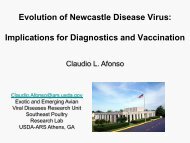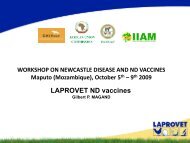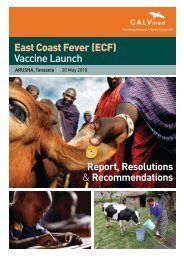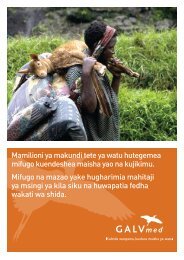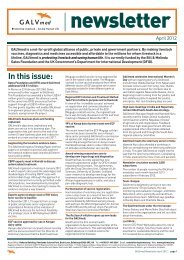A Path to Prosperity New Directions for African Livestock
GALVmed Impetus Strategy Paper
GALVmed Impetus Strategy Paper
- No tags were found...
You also want an ePaper? Increase the reach of your titles
YUMPU automatically turns print PDFs into web optimized ePapers that Google loves.
Regional Economic Communities<br />
The RECs all have agricultural strategies that<br />
reflect the needs of their member states.<br />
For example, the Common Market <strong>for</strong> Eastern and<br />
Southern Africa’s (COMESA) strategic agricultural<br />
goal is <strong>to</strong> achieve improved food security in the<br />
region, with member states recognising that attaining<br />
food security is not possible without achieving<br />
agricultural sec<strong>to</strong>r competitiveness. Un<strong>for</strong>tunately,<br />
most RECs tend <strong>to</strong> be severely handicapped by staff<br />
shortages and are often heavily reliant on project<br />
funded staff <strong>to</strong> achieve results. One REC addressing<br />
this is the Economic Community of West <strong>African</strong><br />
States (ECOWAS), a regional group of fifteen.<br />
ECOWAS Heads of State recently broke with the past<br />
by deciding <strong>to</strong> trans-<strong>for</strong>m the ECOWAS Secretariat<br />
in<strong>to</strong> a Commission. This will not only see an increase<br />
in the number of officers at management level; it<br />
means ECOWAS becomes a supranational body<br />
capable of <strong>for</strong>mulating Acts that are binding on<br />
Member States and the institutions of the<br />
Community.<br />
At the continental level, the Comprehensive Africa<br />
Agriculture Development Program (CAADP) provides<br />
overarching guidance <strong>to</strong> lives<strong>to</strong>ck sec<strong>to</strong>r<br />
development and the Interafrican Bureau of Animal<br />
Resources [AU/IBAR] provides specific technical<br />
and coordination support.<br />
CAADP<br />
The <strong>African</strong> Union’s Direc<strong>to</strong>rate <strong>for</strong> Rural Economy<br />
and Agriculture (DREA) is responsible <strong>for</strong><br />
continental-level strategy development and coordination<br />
of food security, lives<strong>to</strong>ck, environment,<br />
water, natural resources and desertification. DREA<br />
overseas the CAADP which is coordinated by the<br />
NEPAD Planning and Coordinating Agency (NPCA),<br />
<strong>for</strong>merly known as the <strong>New</strong> Partnership <strong>for</strong> Africa’s<br />
Development (NEPAD) Secretariat. CAADP was<br />
established by the AU assembly in 2003. It originates<br />
from the failure of previous agricultural interventions<br />
on the continent, which have been largely attributed<br />
<strong>to</strong> their weak ownership by <strong>African</strong> States. DREA<br />
also supports AU/IBAR in Nairobi.<br />
CAADP is important. It is an <strong>African</strong>-led and <strong>African</strong>owned<br />
idea <strong>for</strong> agricultural development. It brings<br />
<strong>to</strong>gether diverse key players at all levels and has<br />
significant support. <strong>African</strong> governments have<br />
agreed <strong>to</strong> increase public investment in agriculture<br />
by a minimum of 10% of their national<br />
budgets 11 . CAADP plans <strong>to</strong> raise agricultural<br />
productivity by at least 6% by 2015. This 6%<br />
increase is <strong>to</strong> be achieved through the following<br />
outputs:<br />
> Dynamic agricultural markets within countries<br />
and between regions in Africa;<br />
> Farmers taking part in the market economy and<br />
enjoying good access <strong>to</strong> markets so that Africa,<br />
capitalising on its comparative and competitive<br />
advantages, becomes a net exporter of<br />
agricultural products;<br />
> Rural populations having more equitable access<br />
<strong>to</strong> land, physical and financial resources, and<br />
knowledge, in<strong>for</strong>mation and technology <strong>for</strong><br />
sustainable development;<br />
> Africa playing a strategic role in agricultural<br />
science and technology, meeting the growing<br />
needs and demands of <strong>African</strong> agriculture; and<br />
> Environmentally sound agricultural production<br />
and a culture of sustainable management of<br />
natural resources as a result of better<br />
knowledge, more in<strong>for</strong>mation and the<br />
application of technology.<br />
CAADP is not a set of supranational programmes,<br />
but a framework embodying a set of key principles<br />
and targets. In line with analysis developed in the<br />
2008 World Development Report on Agriculture,<br />
CAADP recognises that no single agricultural<br />
development process fits all countries. Countries<br />
are guided <strong>to</strong> implement the CAADP agenda in<br />
their own way through a national-level consultation<br />
process that results in a ‘Compact’. The<br />
consultations generally use CAADP’s four “Pillars,”<br />
<strong>to</strong> guide them, these are:<br />
1 Extending the area under rural infrastructure<br />
and reliable water control systems;<br />
2 Improving rural infrastructure and trade-related<br />
capacities <strong>for</strong> market access;<br />
3 Increasing food supply, reducing hunger and<br />
improving responses <strong>to</strong> food emergency crises;<br />
and<br />
4 Improving agriculture research, technology<br />
dissemination and adoption.<br />
11 To date eight countries have reached or surpassed the 10 % target<br />
The Impetus Strategy Paper I Page 53



